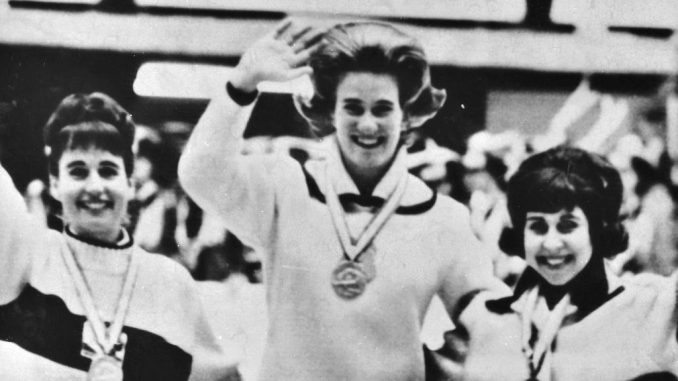
Sjoukje Dijkstra: figure skating pioneer with phenomenal jumping power
After her first world title in 1962 in Prague, father Dijkstra thought it was enough. It was time for Sjoukje to capitalize on her qualities as a figure skater in the ice revue. But no, my daughter decided differently. She already had Olympic silver in her pocket and perhaps there was more to come. “He thought the world title was enough, but I didn’t,” said the died on Thursday Dijkstra about that.
A logical thought. Five-time world champion Carol Heiss had kept 18-year-old Dijkstra from winning the gold medal in Squaw Valley, but the American had retired after that success. That alone paved the way to Olympic glory.
Dijkstra did not disappoint himself or the nation, which in those years was certainly not spoiled by Dutch sporting successes at a global level and eagerly allowed itself to be carried away by the figure skating hype. She won gold in Innsbruck under the eye of the royal family and thus wrote history: never before had the red, white and blue hung from the highest mast at the Winter Games.
Apollo Hall
Dijkstra was born in 1942 in Akkrum, Friesland, but moved to Amstelveen before her first birthday, where her father started working as a general practitioner. It was no wonder that she decided to put on skates as a child: father Lou had participated in the 1936 Olympic Games as a long-track skater.
 The impressive career of figure skating icon Sjoukje Dijkstra (1942-2024)
The impressive career of figure skating icon Sjoukje Dijkstra (1942-2024)
It was less obvious that Sjoukje chose figure skating, because that sport hardly existed in the Netherlands. She did her exercises in the Apollo Hall, where trainer Annie Verlee took care of her and also took her to The Hague when the Amsterdam location closed its doors. Dad Dijkstra drove back and forth with his daughter almost every day.
In the Hofstad she met the slightly older Joan Haanappel. The girls were only nine and ten years old when they flew with Verlee on a transport plane – for free, but among the heads of lettuce – to England to train there under champion maker Arnold Gerschwiler, the strict and aloof Swiss. A ‘not bad’ from his mouth was considered a great compliment.
Jumping power
The efforts turned out not to have been in vain. Sjoukje initially stood in the shadow of her training companion and friend who won four national titles in a row, but after the tables were turned for the first time at the 1959 National Championships, Dijkstra rose to great, inimitable heights.
Almost literally even, because while the slender Haanappel could bring her elegance and grace into battle, Dijkstra had to rely mainly on her phenomenal jumping power. Moreover, she was able to fall back on an iron mentality that came in handy both in training and on the competition ice.
“A day without training was a lost day. I could never catch up on it,” she once reflected in an interview on her efforts to get the best out of herself. “Train, train and never be satisfied, that’s what I thought.” Verlee praised her competitive attitude: “Nerves played a good role in Sjoukje. She was mentally strong, no nonsense, combative.”
Crowning glory
Her talent and training brought her Olympic success in addition to six national (1959-1964), five European (1960-1964) and three world titles (1962-1964). At her first Winter Games in 1956 in Cortina d’Ampezzo, the then 14-year-old Dijkstra finished twelfth, but four years later she was already on the podium in Squaw Valley with silver.
 The crowning achievement came in 1964, when she waved and swung to Olympic gold. A historic plaque for the Netherlands, because the first ever main prize at the Winter Games. Moreover, it would not be until the victory of snowboarder Nicolien Sauerbreij in 2010 that the Wilhelmus was again played for a Dutch winter sports enthusiast who was not a long-track skater.
The crowning achievement came in 1964, when she waved and swung to Olympic gold. A historic plaque for the Netherlands, because the first ever main prize at the Winter Games. Moreover, it would not be until the victory of snowboarder Nicolien Sauerbreij in 2010 that the Wilhelmus was again played for a Dutch winter sports enthusiast who was not a long-track skater.
Her performance in the Olympic arena, rated a maximum ‘six’, not only earned Dijkstra eternal fame in the Netherlands – ‘Sjoukje’ became a household name – but she was also appointed Knight in the Order of Orange-Nassau. She received the decorations one day before the funeral of her father who died in an accident. “I thought it was a great pity that he didn’t experience that. Because he always hoped that I would get that.”
Holiday on Ice
His death also made her think about her future. “I would have liked to have competed. But hey, you can’t eat medals. And then Mr. Gerschwiler helped me get a good contract at an ice show.” That became Holiday on Ice, with which the champion was associated until 1972.
Dijkstra, who met her husband Karl Kossmayer, a dresser with a circus background, at that ice revue, was chosen as Sportswoman of the Year six times (1959-1964). In 2005 she received the Fanny Blankers-Koen Trophy, an award for which only the greatest athletes in our country are eligible.

Be the first to comment